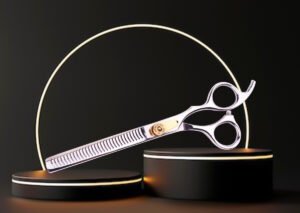Professional hair-cutting scissors are essential tools for stylists, but there are many myths surrounding their use, care, and selection. Below are some common myths and the facts that debunk them.
1. Myth: All Scissors Are the Same
Fact: Not all hair-cutting scissors are created equal. Professional scissors are designed with precision, balance, and durability in mind, making them vastly different from regular household or craft scissors. Professional scissors have sharper blades and are made from high-quality materials like stainless steel or cobalt, which ensures a clean, precise cut. Using non-professional scissors can lead to uneven cuts, split ends, and a poor overall finish.
2. Myth: The More Expensive the Scissors, the Better the Cut
Fact: While price can be an indicator of quality, it doesn’t guarantee that the most expensive scissors are the best choice for every stylist. The right pair of scissors depends on factors like your cutting style, hand size, and personal preference. An expensive pair of scissors may not be suitable if it doesn’t fit your hand well or doesn’t suit your cutting techniques. It’s important to choose scissors that match your needs, not just the price tag.
3. Myth: You Can Use Any Scissors to Cut Hair
Fact: Using the wrong type of scissors, such as kitchen or paper scissors, can damage the hair. These scissors are not designed for cutting hair and have blades that are too thick and dull for clean cuts. This can cause the hair to fray or split, leading to an unprofessional finish. Hair-cutting scissors are specifically designed with fine, sharp blades that glide through hair, providing a smooth, precise cut.
4. Myth: You Don’t Need to Sharpen Professional Scissors Often
Fact: Regular maintenance, including sharpening, is essential to keep professional scissors in top condition. Even the highest-quality scissors will dull over time with regular use. Dull scissors can tug on hair, cause split ends, and make cutting more difficult and less precise. Depending on how frequently you use them, scissors should be sharpened every 3 to 6 months to maintain their effectiveness.
5. Myth: All Scissors Are Suitable for Every Haircut
Fact: Different haircuts require different types of scissors. For example, thinning scissors are used for texturizing and blending, while straight-edge scissors are used for precision cuts. Additionally, the size and weight of the scissors can affect how well they perform for specific techniques. Using the wrong scissors for a particular style can lead to uneven or undesirable results.
6. Myth: The Length of the Scissors Doesn’t Matter
Fact: The length of the scissors is important and should be chosen based on the stylist’s hand size and the type of cuts they perform. Shorter scissors (4.5 to 5.5 inches) offer more precision and are ideal for detailed work, such as cutting around the ears or doing intricate layering. Longer scissors (6 to 7 inches) are better suited for techniques like slide cutting or cutting larger sections of hair. Choosing the right length can improve control and comfort during cutting.
7. Myth: Scissors with a Higher Rockwell Hardness (HRC) Are Always Better
Fact: While a higher Rockwell Hardness (HRC) indicates that the steel is harder, it doesn’t always mean the scissors are better. Harder steel can hold an edge longer but may also be more brittle and prone to chipping if not handled properly. Scissors with a moderate HRC offer a balance between durability and flexibility, making them less likely to chip while still providing a sharp edge.
8. Myth: You Can Use the Same Scissors on Wet and Dry Hair
Fact: While some professional scissors are versatile enough to handle both wet and dry hair, others are specifically designed for one or the other. Wet hair requires scissors with a sharp, precise edge to cut cleanly without tugging, while dry hair may need scissors with a micro-serrated edge to prevent slipping. Using the wrong scissors on wet or dry hair can affect the quality of the cut.
9. Myth: Professional Scissors Don’t Need Regular Cleaning
Fact: Regular cleaning and maintenance are crucial to prolonging the life of professional scissors. Hair, dust, and product residue can build up on the blades, affecting their sharpness and performance. Scissors should be cleaned after each use and oiled regularly to ensure smooth operation. Neglecting to clean and maintain your scissors can lead to corrosion, dull blades, and a shorter lifespan.
10. Myth: Titanium-Coated Scissors Are the Best
Fact: Titanium coating on scissors offers benefits like corrosion resistance and a smooth surface, but it doesn’t necessarily make them the best choice for everyone. The coating can wear off over time, and it doesn’t affect the sharpness or overall quality of the scissors. What matters more is the quality of the steel and the craftsmanship behind the scissors. Titanium-coated scissors can be a good option, but they’re not inherently superior to non-coated ones.
Final Thoughts
Understanding the myths and facts surrounding professional hair cutting scissors can help stylists make informed decisions about their tools. By choosing the right scissors, maintaining them properly, and using them as intended, you can achieve better results in your haircuts and prolong the life of your tools.



